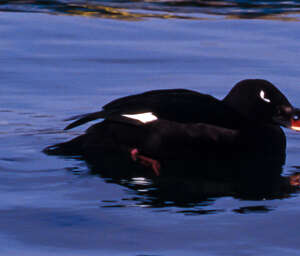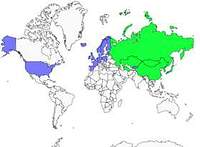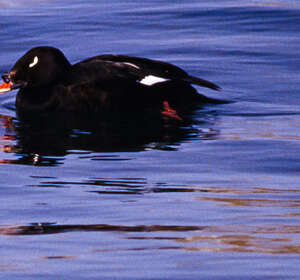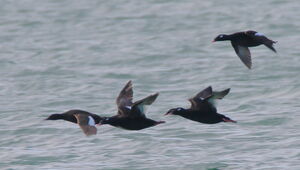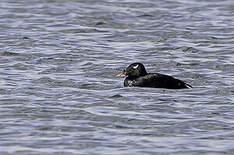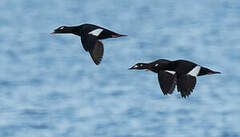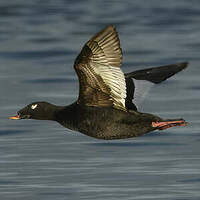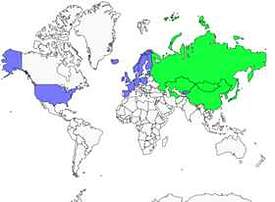Stejneger's Scoter
Melanitta stejnegeri - Macreuse de Sibérie
Identification
Stejneger's Scoter is a large diving duck in the east of the Eurasian continent. The former taxon Macleae duck has recently been split into 3 new species, the Eurasian Macreuse duck (or simply macreuse duck), the Stejneger's Scoter, which we are interested in here, and which occupies the eastern part of the continent and the White-winged Macreuse duck that occupies the northern part of the North American continent. Stejneger's Scoter has thus become monotypic.
Stejneger's Scoter is very close in all respects to the macreuse duck, to the point that the taxon is not yet recognized by all. It is recognized by the IOC*, hence its inclusion in oiseaux.net.
I will only mention what distinguishes it from the macreuse duck. The adult male in nuptial plumage has an even more exotic beak. The upper mandible is bicolored, red on the culmen and 3/4 of the top, yellow-orange on the remaining quarter. A black line, more or less important, marks the lower limit. The lappet is dark orange. But above all, at the base of the beak, the black swelling is much more developed and overlooks the nostrils, like a wattle. The day can be seen through the joint nostrils.
The female is very similar to the female macreuse duck. Same dark brown plumage, same pale areas on the sides of the head. In some, a slight puffiness is visible in the upstream nostrils, which allows identification.
The juvenile is female type but paler, with larger and paler head spots.
*See Bibliography
Subspecific information monotypic species
Foreign names
- Macreuse de Sibérie,
- Negrón siberiano,
- negrola-siberiana,
- Kamtschatkasamtente,
- Aziatische Grote Zee-eend,
- Orco marino di Stejneger,
- sibirisk knölsvärta,
- Sibirsjøorre,
- turpan bielokrídly,
- turpan sibiřský,
- Asiatisk Fløjlsand,
- ànec fosc siberià,
- uhla azjatycka,
- Āzijas pīle,
- ビロードキンクロ,
- 斑脸海番鸭,
Habitat
Stejneger's Scoter breeds around small freshwater ponds in the boreal forest and the southern part of the arctic tundra, along inland waters well inland.
The small, isolated population in Kazakhstan breeds in high altitude waters up to 2,000 m.
It winters mostly at sea, usually in the shallower, fish-rich coastal waters. A small number of birds occasionally winter on favorable freshwater bodies. The youngsters stay at sea at the end of the winter and spend their entire second year there.
Flight
Dietfeeding habits
Stejneger's Scoter feeds in the same way as the Common Scoter, by diving using its webbed feet and wings. It captures its prey from its beak between two waters, but mainly from the bottom or even from the soft substrate. During the summer season, it mostly samples among insects, crustaceans and freshwater molluscs. In winter, marine molluscs play an important role in its diet, both bivalves and gastropods. On the coasts of Japan, it mainly feeds on crabs at depths of 30-40 m, which speaks for its diving abilities.
Reproduction nesting
The breeding season usually starts at the end of May or in June, and the birds will leave their sites between August and October. Monogamy is the rule, with one egg clutch. The couples defend a small territory around the nest, which is an advantage when the territories are contiguous in advantageous places. This allows for good density of nesting couples in the vicinity of water areas. They are often close to seabird colonies. The nest is a shallow depression, lined sparsely with vegetation recovered from the surroundings, and hidden away with vegetation. The egg clutch consists of 6 to 9 white-rusty eggs, laid at a rate of one every 36 hours. The female alone incubates them, probably for a period close to that of the common scoter. The chicks are covered with dark brown feathers on top, white feathers underneath, down to the bottom of the neck. Juveniles fly at 50-55 days.
Geographic range
Stejneger's Scoter breeds in the northern parts of Russia, from the Khatanga basin to the Kamchatka peninsula, south to Mongolia and locally in the northeast of Kazakhstan. It also nests on Sakhalin Island. It winters at sea along the Pacific coasts of the mainland, Kamchatka, south of the Sea of Okhotsk, Korean peninsula and Chinese coast, and its islands, Commander Islands, Kuril Islands and Japanese archipelago.
Threats - protection
IUCN conservation status
concern
in the Wild
threatened
evaluated
At present, the species is not classified as threatened, but it has been reported to be in decline in several regions without being precisely quantified. It is therefore a species to watch, but counting at sea is not easy to do and to reproduce regularly.
Sources of information
- IOC World Bird List (v14.2), Gill, F and D Donsker (Eds). 2024-04-18.
- Avibase, Lepage Denis
- Birds of the World, The Cornell Lab of Ornithology
Other sources of interest
 Specification sheet created on
27/07/2023 by Jean François
Specification sheet created on
27/07/2023 by Jean FrançoisTranslation by AI Oiseaux.net
© 1996-2025 Oiseaux.net
- Accipitriformes
- Aegotheliformes
- Anseriformes
- Apodiformes
- Apterygiformes
- Bucerotiformes
- Caprimulgiformes
- Cariamiformes
- Casuariiformes
- Charadriiformes
- Ciconiiformes
- Coliiformes
- Columbiformes
- Coraciiformes
- Cuculiformes
- Eurypygiformes
- Falconiformes
- Galliformes
- Gaviiformes
- Gruiformes
- Leptosomiformes
- Mesitornithiformes
- Musophagiformes
- Nyctibiiformes
- Opisthocomiformes
- Otidiformes
- Passeriformes
- Pelecaniformes
- Phaethontiformes
- Phoenicopteriformes
- Piciformes
- Podargiformes
- Podicipediformes
- Procellariiformes
- Psittaciformes
- Pterocliformes
- Rheiformes
- Sphenisciformes
- Steatornithiformes
- Strigiformes
- Struthioniformes
- Suliformes
- Tinamiformes
- Trogoniformes

